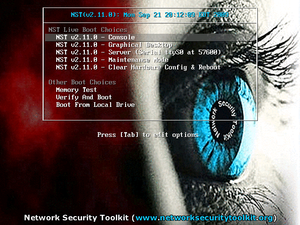Difference between revisions of "Getting Started"
(→After Booting) |
(→Image:Warning.png Default Password) |
||
| Line 49: | Line 49: | ||
The default password is: ''nst2003''. | The default password is: ''nst2003''. | ||
| − | + | Here are some things to be aware of related to the NST system passwords: | |
| − | + | * Network access to your NST system will be disabled until you change the default password (the '''sshd''' and '''https''' services will not be running). | |
| − | + | * You should use the '''nstpasswd''' command after logging in to change the default password. This changes not just the ''root'' password, but many other password entries and enables the '''sshd''' and '''https''' services. | |
| − | + | * You will need to run the '''nstpasswd''' command each time you boot NST Live without a persistence overlay. | |
| + | * If you boot NST Live with a persistence overlay (for example from a USB drive), you will only need to run the '''nstpasswd''' command the first time you boot the system and each time you boot the system after clearing your persistence layer. | ||
| + | |||
| + | * If you boot NST from a full installation, you will only need to run the '''nstpasswd''' command the first time you log into the system. | ||
== [[Image:Warning.png]] For NST Live Usage == | == [[Image:Warning.png]] For NST Live Usage == | ||
Revision as of 06:24, 25 September 2009
Contents
What Files Can I Download And Use?
Full NST Live Distribution
This file contains the full NST distribution and is known as: "NST Live". It is a Live bootable Linux distribution based on Fedora and provides easy access to best-of-breed Open Source Network Security Applications and should run on most x86/x86_64 platforms. One can download this file, burn it to a DVD, boot the DVD and then start using NST.
NST Minimal Live
The size of the full "NST Live ISO" is much larger than can fit on CD media. For those systems that can not boot off of a DVD or a USB flash drive and the intent is to install NST to the system hard drive, use this minimal NST Live ISO. This ISO contains all the necessary files to build the full NST distribution. See the NST Minimal section for installation of a NST Minimal Live ISO.
NST VM Configuration Archive
A Zip archive that contains the configuration files necessary for booting NST Live under VMware Player, Server or Workstation for those folks that want to build their own NST Virtual Machine (VM).
PreBuilt Virtual Machine Archive
A prebuilt Virtual Machine archive that contains the full NST distribution which can be easily launched using VMware Player, Server or Workstation for those folks that do not want to build their own VM using NST Live.
NST Source Archive
This compressed archive contains the entire source tree used to build the NST distribution.
NST Web Site Documentation
This compressed archive contains a snapshot of the NST web site at the time of the distribution release.
NST PDF Documentation
This compressed archive contains a snapshot of the NST documentation in PDF format at the time of the distribution release.
What Can I Do With The NST Live ISO Image?
Burn To DVD
Create Bootable USB Thumbdrive
Boot It Under VMware
Booting The System
Console
The text based console interface is the default boot more for NST Live. If you don't type anything, your NST Live system should automatically boot in this mode. To skip the delay, simply press the Enter Key while the Console boot option is highlighted.
Graphical Desktop
If you'd prefer to use a graphical Fluxbox or GNOME desktop, use the down arrow key to select the Graphical Desktop option and press the Enter Key on the screen below:
After Booting
 Default Password
Default Password
The default password is: nst2003.
Here are some things to be aware of related to the NST system passwords:
- Network access to your NST system will be disabled until you change the default password (the sshd and https services will not be running).
- You should use the nstpasswd command after logging in to change the default password. This changes not just the root password, but many other password entries and enables the sshd and https services.
- You will need to run the nstpasswd command each time you boot NST Live without a persistence overlay.
- If you boot NST Live with a persistence overlay (for example from a USB drive), you will only need to run the nstpasswd command the first time you boot the system and each time you boot the system after clearing your persistence layer.
- If you boot NST from a full installation, you will only need to run the nstpasswd command the first time you log into the system.
 For NST Live Usage
For NST Live Usage
- Login as the root user with the initial default password of nst2003
- Run nstpasswd to change the default system passwords (this will also enable the sshd and httpd service).
 To Install To Hard Disk
To Install To Hard Disk
- Login as the root user with the initial default password of nst2003
- Run nstpasswd to change the default system passwords (this will also enable the sshd and httpd service).
Console Mode
Graphical Desktop Session
- Login as the Live System User using the default password of nst2003.
- Double click on the Install icon on the desktop.
- Reboot the system.
